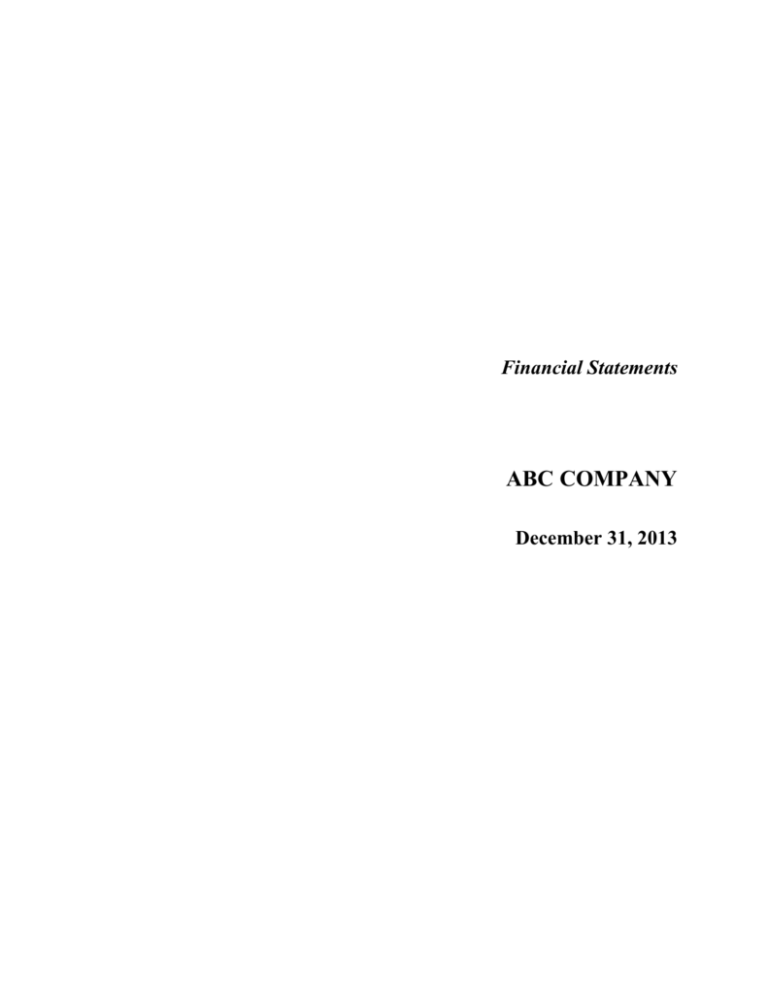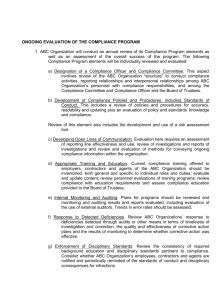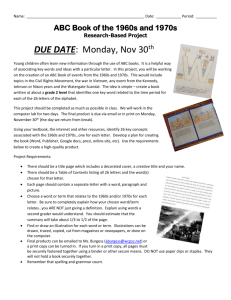Notes to Financials Template
advertisement

Financial Statements ABC COMPANY December 31, 2013 ABC COMPANY INDEPENDENT AUDITOR'S REPORT and FINANCIAL STATEMENTS and SUPPLEMENTAL INFORMATION December 31, 2013 ABC COMPANY City and State December 31, 2013 TABLE O F C O N TEN TS Page Independent Auditor's Report Financial Statements: Statement of Financial Condition 2 Statement of Income 3 Statement of Stockholders’ Equity 4 Statement of Cash Flows 5 Statement of Changes in Liabilities Subordinated to Claims of General Creditors 6 Notes to Financial Statements 7-11 Supplemental Information: Computation of Net Capital Pursuant to Rule 15c3-1(1) 12 Reconciliation Pursuant to Rule 17a-5(d)(4) 13 Independent Auditor’s Report on Internal Control Required by SEC Rule 17a-5 for a Broker-Dealer Claiming an Exemption from SEC Rule 15c3-3 Independent Accountants’ Report on Applying Agreed-Upon Procedures Related to an Entity’s SIPC Assessment Reconciliation 14-15 16 ABC COMPANY Notes to Financial Statements December 31, 2013 1. SUMMARY OF SIGNIFICANT ACCOUNTING POLICIES This summary of significant accounting policies of ABC Company (the “Company”) is presented to assist in understanding the Company’s financial statements. The financial statements and notes are representations of the Company’s management who are responsible for their integrity and objectivity. These accounting policies conform to accounting principles generally accepted in the United States of America and have been consistently applied in the preparation of the financial statements. Nature of Operations - The Company provides services as a registered broker and dealer. Revenues and expenses consist primarily of commissions received and paid, fees received from and paid on behalf of registered representatives, and travel to recruit and oversee registered representatives. Security Trading - On security trades by customers, the Company acts as the introducing broker on a fully disclosed basis. Customer accounts are maintained on the books of the carrying broker. Basis of Accounting - The Company maintains its accounts on the accrual basis of accounting in accordance with accounting principles generally accepted in the United States of America. Accounting principles followed by the Company and the methods of applying those principles, which materially affect the determination of financial position, results of operations and cash flows are summarized below. Cash and Cash Equivalents - For purposes of the statement of cash flows, the Company considers all highly liquid debt instruments purchased with a maturity of three months or less to be cash equivalents. Accounts Receivable – Registered Representatives - Accounts receivable from registered representatives include administrative and supervisory fees charged to the representatives for licensing, continuing education and supervision. The Company provides an allowance for doubtful accounts, which is based upon review of outstanding receivables, historical collections information and existing economic conditions. Bad debt expense for the year ended December 31, 2013 was $ . Commissions Receivable and Payable - Commissions receivable and payable are booked at the time of sale. Property and Equipment – Property and equipment are carried at cost, less accumulated depreciation. Depreciation is computed primarily by use of the straight-line method. When assets are retired, or otherwise disposed of, the cost and related accumulated depreciation are removed from the accounts, and any gain or loss is reflected in current operations. Maintenance and repairs are charged to operations when incurred. Costs of betterments and renewals are capitalized and depreciated over their estimated useful lives. 7 ABC COMPANY Notes to Financial Statements December 31, 2013 1. SUMMARY OF SIGNIFICANT ACCOUNTING POLICIES (continued) Use of Estimates - The preparation of financial statements in conformity with generally accepted accounting principles requires management to make estimates and assumptions that affect the reported amounts of assets and liabilities and disclosure of contingent assets and liabilities at the date of the financial statements and the reported amounts of revenues and expenses during the reporting period. Actual results may differ from those estimates. Personnel Policies - The Company pays its registered representatives on a commission basis and considers registered representatives to be self-employed. No taxes are withheld on commissions paid. Sales – Other Income - Other income reported in sales consists of commissions received on mutual fund (12b) transactions. Capital Gains (Losses) - The Company does not trade on its own behalf. Advertising incurred. The Company’s policy is to expense advertising costs as the costs are Significant Group Concentrations of Credit Risk – The Company maintains deposits in a financial institution that at times exceed amounts covered by insurance provided by the U.S. Federal Deposit Insurance Corporation (FDIC). The Company believes that there is no significant risk with respect to these deposits. 2. PROPERTY AND EQUIPMENT Estimated Useful Life Equipment Furniture and fixtures Leasehold improvements Accumulated Depreciation Net Book Value $ $ $ $ $ $ Cost # of years # of years # of years Depreciation charged to operations of property and equipment for 2013 was $ 8 . ABC COMPANY Notes to Financial Statements December 31, 2013 3. RELATED PARTY TRANSACTIONS leases the building that houses the Company’s office. are the current president and vice president of the Company. to during 2013 and 2012 were $ and $ 12 months of rent. 4. shareholders Total payments , respectively, for RESTRICTIONS ON CASH The Company is required by its clearing firm to maintain $ in a house account with them. The balance in this account at December 31, 2013 and 2012 was $ and $ , respectively, all of which has been reported as restricted cash under other assets. 5. LEASES The Company leases its offices for $ month and there is no contract. 7. per month. The lease is month-to- NET CAPITAL REQUIREMENTS The Company is subject to the Securities and Exchange Commission Uniform Net Capital Rule (SEC Rule 15c3-1), which requires the maintenance of minimum net capital and requires that the ratio of aggregate indebtedness to net capital, both as defined, shall not exceed 15 to 1 (and the rules of the “applicable” exchange also provides that equity capital may not be withdrawn or cash dividends paid if the resulting net capital ratio would exceed 10 to 1). At December 31, 2013, the Company had net capital of $ which was $ in excess of its required net capital of $ . Additionally, the Company’s ratio of aggregate indebtedness to net capital was to 1. 8. CONTROL REQUIREMENTS There are no amounts, as of December 31, 2013 and 2012, to be reported pursuant to the possession or control requirement under Rule 15c3-3. The Company is in compliance with the exemptive provisions of Rule 15c3-3 under paragraph (k)(2)(ii) and thus is exempt from the provisions of Rule 15c3-3. 9 ABC COMPANY Notes to Financial Statements December 31, 2013 9. RECONCILIATION PURSUANT TO RULE 17a-5(d)(4) Based on the Company’s computation of net capital under Rule 15c3-1, as of December 31, 2013 and 2012, there were differences noted with the Company’s unaudited reports. See page 13 of this report for a comparison of the Computation of Net Capital per the audited financial statements and the unaudited financial statements. 10. ACCOUNTING FOR UNCERTAIN TAX POSITIONS Generally accepted accounting principles require the adoption of the accounting standard regarding “Accounting for Uncertain Tax Positions”. This standard provides detailed guidance for financial statement recognition, measurement, and disclosure of uncertain tax positions recognized in the enterprise’s financial statements. It requires an entity to recognize the financial statement impact of a tax position when it is more likely than not that the position will be sustained upon examination. The adoption of this standard had no material effect on the Company’s financial position, results of operations, or cash flow. The tax years prior to 20XX generally are not subject to examination by the U.S. Federal and most state tax authorities. 11. INCOME TAXES Deferred tax assets and liabilities represent the tax effects of taxable temporary differences in book an tax reporting. Significant difference between tax and financial reporting that five rise to deferred tax assets and liabilities are as follows at December31, 2013: 2013 Deferred tax asset (liability) Bad debts Depreciation $ Net Asset (Liability) $ A provision (benefit) for income taxes consists of the following: 2013 Provision (benefit): Current Deferred $ $ 10 ABC COMPANY Notes to Financial Statements December 31, 2013 11. INCOME TAXES (continued) A reconciliation of income tax expense at the statutory rate to income tax expense at the Company’s effective rate is shown below: Dollars 2013 Income(loss) before income taxes $ Federal Statutory income tax State income taxes Nondeductible expense and other 100% % % % Income tax provision (benefit) 12. Percent of Pretax Income 2013 $ % SUBSEQUENT EVENTS In preparing these financial statements management has evaluated and disclosed all material subsequent events through ENTER DATE, which is the date these statements were available to be issued. 11 Supplemental Information ABC COMPANY Computation of Net Capital Pursuant to Rule 15c3-1(1) December 31, 2013 Net Capital Ownership equity $ Less non-allowable assets: Deposits Receivables from non-customers, net of allowance Net fixed assets Deferred tax (liability) asset Total allowable capital Less haircuts on investments Total net capital Minimum capital requirement Excess Over (Under) Minimum Net Capital Requirement Total Aggregate Indebtedness $ $ Ratio of Aggregate Indebtedness to Net Capital There are no material differences between the above computation and the computation included in the Company’s corresponding unaudited form X-17A-5 Part IIA filing. See independent auditor’s report. 12 ABC COMPANY Reconciliation Pursuant to Rule 17a-5(d)(4) December 31, 2013 Per Audited Report Net Capital Ownership equity Per Unaudited Report $ $ $ $ Less non-allowable assets: Deposits Receivables from non-customers Net fixed assets Deferred tax (liability) asset Total allowable capital Less haircuts on investments Total net capital Minimum capital requirement Excess Over Minimum Net Capital Requirement Total Aggregate Indebtedness Ratio of Aggregate Indebtness to Net Capital See independent auditor’s report. 13




